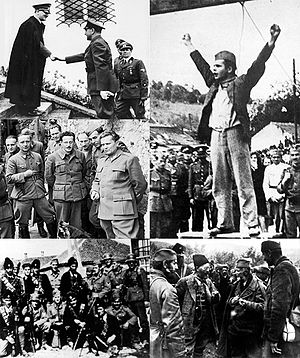
Back الحرب العالمية الثانية في يوغوسلافيا Arabic Югославия във Втората световна война Bulgarian Narodnooslobodilačka borba Jugoslavije BS Front Iugoslau Catalan Druhá světová válka v Jugoslávii Czech Jugoslavien under 2. verdenskrig Danish Β΄ Παγκόσμιος Πόλεμος στη Γιουγκοσλαβία Greek Yugoslavia durante la Segunda Guerra Mundial Spanish جنگ جهانی دوم در یوگسلاوی Persian Front yougoslave de la Seconde Guerre mondiale French
| World War II in Yugoslavia | ||||||||
|---|---|---|---|---|---|---|---|---|
| Part of the European theatre of World War II | ||||||||
 Clockwise from top left: Ante Pavelić visits Adolf Hitler at the Berghof; Stjepan Filipović hanged by the occupation forces; Draža Mihailović confers with his troops; a group of Chetniks with German soldiers in a village in Serbia; Josip Broz Tito with members of the British mission | ||||||||
| ||||||||
| Belligerents | ||||||||
|
April 1941: |
April 1941: | |||||||
| 1941 – September 1943: | 1941–43: |
1941–43:
| ||||||
| September 1943–1945: |
1943–45:
| |||||||
| Strength | ||||||||
|
130,000 (1945)[5] |
(400,000 ill-prepared)[10] |
800,000 (1945)[14] | ||||||
| Casualties and losses | ||||||||
|
19,235-103,693 killed 14,805 missing[18] 9,065 killed 15,160 wounded 6,306 missing 99,000 killed |
245,549 killed 399,880 wounded 31,200 died from wounds 28,925 missing | |||||||
|
Total Yugoslav casualties: ≈850,000[23]–1,200,000 a ^ Axis puppet regime established on occupied Yugoslav territory | ||||||||
World War II in the Kingdom of Yugoslavia began on 6 April 1941, when the country was invaded and swiftly conquered by Axis forces and partitioned among Germany, Italy, Hungary, Bulgaria and their client regimes. Shortly after Germany attacked the USSR on 22 June 1941,[27] the communist-led republican Yugoslav Partisans, on orders from Moscow,[27] launched a guerrilla liberation war fighting against the Axis forces and their locally established puppet regimes, including the Axis-allied Independent State of Croatia (NDH) and the Government of National Salvation in the German-occupied territory of Serbia. This was dubbed the National Liberation War and Socialist Revolution in post-war Yugoslav communist historiography. Simultaneously, a multi-side civil war was waged between the Yugoslav communist Partisans, the Serbian royalist Chetniks, the Axis-allied Croatian Ustaše and Home Guard, Serbian Volunteer Corps and State Guard, Slovene Home Guard, as well as Nazi-allied Russian Protective Corps troops.[28]
Both the Yugoslav Partisans and the Chetnik movement initially resisted the Axis invasion. However, after 1941, Chetniks extensively and systematically collaborated with the Italian occupation forces until the Italian capitulation, and thereon also with German and Ustaše forces.[28][29] The Axis mounted a series of offensives intended to destroy the Partisans, coming close to doing so in the Battles of Neretva and Sutjeska in the spring and summer of 1943.
Despite the setbacks, the Partisans remained a credible fighting force, with their organisation gaining recognition from the Western Allies at the Tehran Conference and laying the foundations for the post-war Yugoslav socialist state. With support in logistics and air power from the Western Allies, and Soviet ground troops in the Belgrade offensive, the Partisans eventually gained control of the entire country and of the border regions of Trieste and Carinthia. The victorious Partisans established the Socialist Federal Republic of Yugoslavia.
The conflict in Yugoslavia had one of the highest death tolls by population in the war, and is usually estimated at around one million, about half of whom were civilians. Genocide and ethnic cleansing was carried out by the Axis forces (particularly the Wehrmacht) and their collaborators (particularly the Ustaše and Chetniks), and reprisal actions from the Partisans became more frequent towards the end of the war, and continued after it.
- ^ D'Amico, F. and G. Valentini. Regia Aeronautica Vol. 2: Pictorial History of the Aeronautica Nazionale Repubblicana and the Italian Co-Belligerent Air Force, 1943–1945. Carrollton, Texas: Squadron/Signal Publications, Inc., 1986.
- ^ Mitrovski, Glišić & Ristovski 1971, p. 211.
- ^ Tomasevich 2001, p. 255.
- ^ Jelić Butić 1977, p. 270.
- ^ Colić 1977, pp. 61–79.
- ^ Mitrovski, Glišić & Ristovski 1971, p. 49.
- ^ Tomasevich 2001, p. 167.
- ^ Tomasevich 2001, p. 183.
- ^ Tomasevich 2001, p. 771.
- ^ Tomasevich 1975, p. 64.
- ^ Microcopy No. T314, roll 566, frames 778 – 785
- ^ Borković, p. 9.
- ^ Zbornik dokumenata Vojnoistorijskog instituta: tom XII – Dokumenti jedinica, komandi i ustanova nemačkog Rajha – knjiga 3, p. 619
- ^ Perica 2004, p. 96.
- ^ Giacomo Scotti Ventimila caduti. Italiani in Iugoslavia 1943–45, printed by Mursia in Milan, 1970: in page 492 there is text regarding division Italia
- ^ "article by Giacomo Scotti" (PDF).
- ^ Sorge, Martin K. (1986). The Other Price of Hitler's War: German Military and Civilian Losses Resulting from World War II. Greenwood Publishing Group. pp. 62–63. ISBN 978-0-313-25293-8.
- ^ Overmans, Rüdiger (2000). Deutsche militärische Verluste im Zweiten Weltkrieg. p. 336
- ^ Geiger 2011, pp. 743–744.
- ^ Geiger 2011, pp. 701.
- ^ A'Barrow 2016.
- ^ Žerjavić 1993.
- ^ Mestrovic 2013, p. 129.
- ^ Tomasevich 2001, p. 226.
- ^ Ramet 2006, p. 147.
- ^ Tomasevich 2001, p. 308.
- ^ a b Ramet 2006, p. 142.
- ^ a b Ramet 2006, pp. 145–155.
- ^ Tomasevich 1975, p. 246.